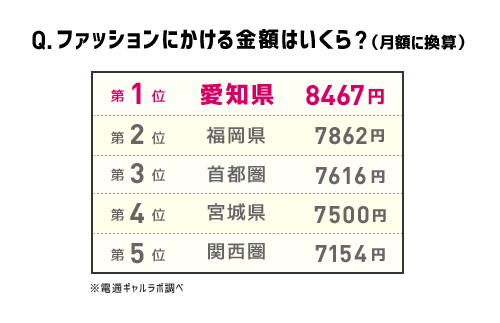
Hello, I'm Shigeto Kasahara from the "Human Flow Lab" at Dentsu Inc. Kansai Branch.
I wanted to meet gals.
While pondering this, I heard that using mobile spatial statistics (*1) provided by Docomo Insight Marketing could reveal human movement patterns. So, together with Haruhide Morishita, aka the Little Old Man, also from the Human Flow Lab at the Kansai Branch, we decided to observe the行動範囲 and behavioral insights of gals – just the two of us guys.
Where do gals gather?
On Saturday, September 27, 2014, from 2:00 PM to 3:00 PM, we peeked at "where" women aged 15 to 24 (our definition of "gal" for this project) were located across five regions of Japan: Tohoku, Kanto, Chubu, Kansai, and Kyushu. The criteria for choosing this day were: clear weather nationwide, no special events likely to attract our target demographic (like concerts or fashion events), and pleasant weather that wouldn't significantly impact shopping behavior.
The following diagram shows where the gals were located in the Kanto region. We could see that many gals were in the "city centers" of Ikebukuro, Shinjuku, and Shibuya.
Saitama, Yokohama, and Maihama also have a significant number of gals!
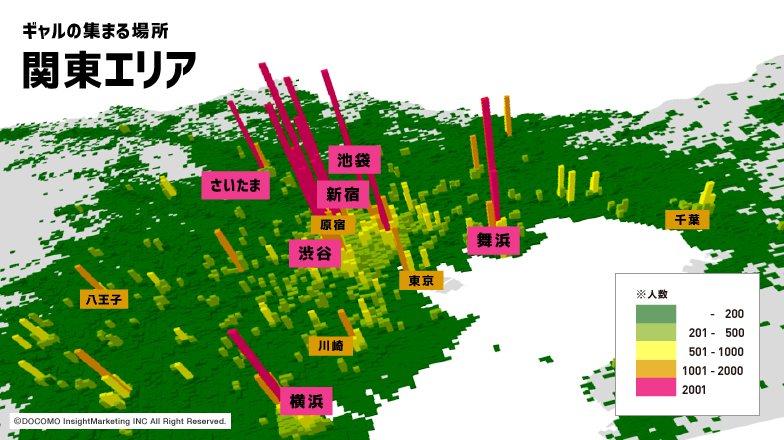
※Mobile Spatial Statistics (TM) Data provided by: NTT DOCOMO, Inc., DOCOMO Insight Marketing, Inc.
By the way, here's the Kansai area.

※Mobile Spatial Statistics (TM) Data provided by: NTT DOCOMO, Inc., DOCOMO Insight Marketing Inc.
Digging a little deeper, we also discovered the following:
Gals go to places they can enjoy even without a car!
We found that gals tend to gather around stations along railway lines extending from the city center. It's suggested that gals come not only to downtown entertainment districts but also to lively spots within their own neighborhoods—namely, "stations." Since they likely have a low car ownership rate, it's reasonable to assume they frequently use railways.
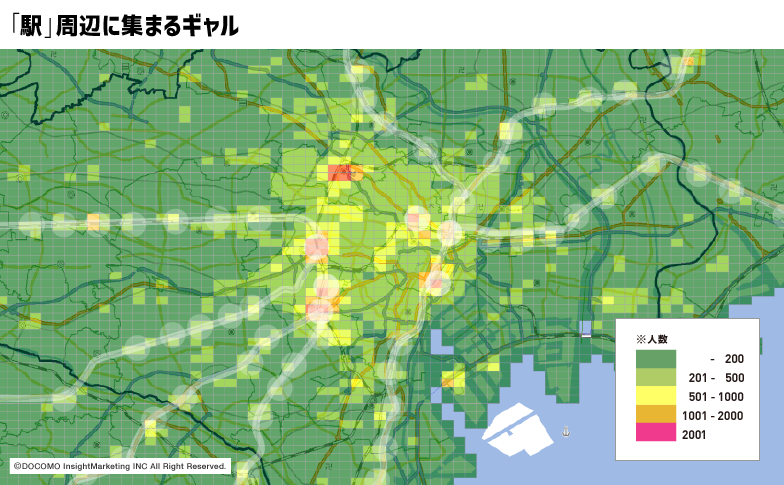
※Mobile Spatial Statistics (TM) Data provided by: NTT DOCOMO, Inc., DOCOMO Insight Marketing, Inc.
Gals also have good relationships with their mothers!
On the other hand, it has also become clear that gals are moving to areas around shopping centers farther from the city center. Below is the distribution of Nagoya gals.
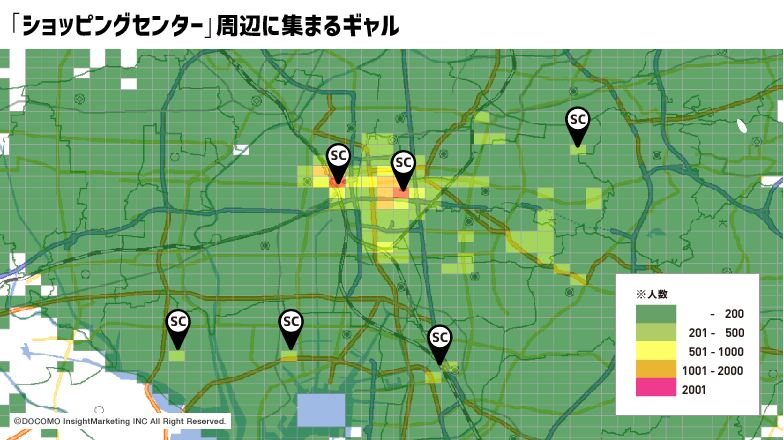
※Mobile Spatial Statistics (TM) Data provided by: NTT DOCOMO, Inc., DOCOMO Insight Marketing Inc.
Even away from the city center, they gather at shopping centers. Shopping centers seem just as appealing to gals as downtown areas. Both downtown shopping districts and shopping centers offer the same "shopping experience." It's safe to say gals "love shopping." However, shopping centers are often located in the suburbs, making them difficult to reach by train. Finding this curious, I sought advice from our in-house Gal Lab@ team.
Aichi Prefecture gals, compared to other regions, show a particularly strong tendency to gather at shopping centers far from the city center. According to Dentsu Inc . Gal Lab@ research (※2) and analysis, compared to gals in other regions, a higher percentage of them "go shopping with their mothers" and also spend more money on shopping. This result aligns with our observations.
Gals love hanging out with friends!
Furthermore, it has become clear that they also gather around schools. For university students, this likely means gathering with club members or close friends for club or circle activities.
When we asked the Gal Lab@ team to listen to the gals' voices again,
"I live near the university, so on days off I do seminar assignments at the library or eat near campus. We often meet for club activities, but convenience is key. We mostly gather around the university area" (20 years old, Osaka resident). This aligns with our survey findings.

※Mobile Spatial Statistics (TM) Data provided by: NTT DOCOMO, Inc., DOCOMO Insight Marketing, Inc.
Gals often move around "to shop or communicate with friends/mothers in fun, lively places." It turns out that going to places matching these conditions means "you can meet gals"!
Chasing Gals Further
We selected multiple areas (500-meter squares) where gals congregated, compared where the gals present came from, and analyzed the data. This revealed that each city's "gal attraction model" could be broadly classified into three types.
Three Urban Models Based on Gal Movement Patterns
① Metropolitan Model (Tokyo, Osaka locations)
・Their travel range is about 60 minutes by train. They come from relatively far away.
・Gals come from all directions.
・While attracting gals from a wide area, the rate of gals living within a 30-minute radius (nearby) is somewhat lower, likely because attractive areas are scattered throughout the same city.
Below is a map showing where gals in Tokyo's Ikebukuro come from. Can you see how it generally reflects the trends mentioned above?

According to research by Gyaru Lab@・Team (※2), metropolitan-style gals seem willing to travel somewhat farther if they want something specific or if there's a trendy spot or event. Particularly in Tokyo, with its large commercial complexes and fashion districts, each area has distinct "things you can only buy here" and "atmospheres you can only experience here," encouraging active exploration.
Previously, it was said that gals living in Saitama typically passed through Ikebukuro on their way to Shinjuku. However, in recent years, with Ikebukuro's development progressing and even being featured on TV programs as a desirable place to live, there's a noticeable trend of more gals staying in Ikebukuro itself.
② Adjacent City Model (Yokohama, Kyoto, Kobe)
・Gals living within a 30-minute commute are highly likely to visit, but those from farther away rarely make the trip.
・Few gals come from the direction of adjacent major cities.
Gals residing between a major city and its adjacent city tend to move less frequently toward the smaller adjacent city. In other words, the adjacent city lacks the pull of the major city. This phenomenon likely means less cultural influx from the major city, suggesting these adjacent cities could develop their own unique cultures.

According to research by Gyaru Lab@・Team, adjacent city gals do have an aspiration for the big city and are proactive in gathering information online and offline. However, they lack the motivation to travel specifically to the major city for shopping, tending to get by locally. They seem to incorporate popular trends to a reasonable extent while aiming for a lifestyle suited to their means.
A 24-year-old gal who lived in Kyoto during her student days and now works in Osaka says:
"When I lived in Kyoto, I could get almost everything I needed shopping-wise within the city. It was crowded and tiring, and I didn't feel the need to go all the way to Osaka where I wasn't familiar with the area. Friends who were really into fashion would go shopping in Osaka, but I basically never left Kyoto."
Conversely, now that she lives in Osaka,
"I don't go out of my way to shop in Kyoto anymore. Once you get used to Osaka, it has more stores and a wider variety of choices."
she says.
③ Regional Core Cities (Sendai, Nagoya, Fukuoka)
・Gals come from quite far away, even over 60 minutes by train.
・Gals come from all directions.
・They attract gals from a wide area, and perhaps because there are few competing areas within the same city, they also draw gals living nearby.
The range from which gals come extends well over 60 minutes by train. You can see gals from Koriyama City, Fukushima Prefecture, going to Sendai (the distance between Sendai and Koriyama exceeds 120 kilometers!).
A similar phenomenon occurs in Fukuoka's Tenjin district, where gals from Shimonoseki cross the Kanmon Strait to reach Tenjin ( Gals crossing the sea! ). The distance between Tenjin and Shimonoseki exceeds 80 km. Even more impressive are the Sasebo gals, who travel over 120 km to Tenjin!!

For regional gals, representative cities like Sendai or Tenjin are like gods—worth traveling great distances to be satisfied! They might also be the one and only destination for nearby gals. In any case, it's clear these regional core cities attract gals.
According to research by Gyaru Lab@・Team (※2), Fukuoka Prefecture gals tend to shop less often alone and more often with their boyfriends. We can infer that regional hub city gals "make the trip even if it's a bit far."
Summarizing the above results yields the following diagram.
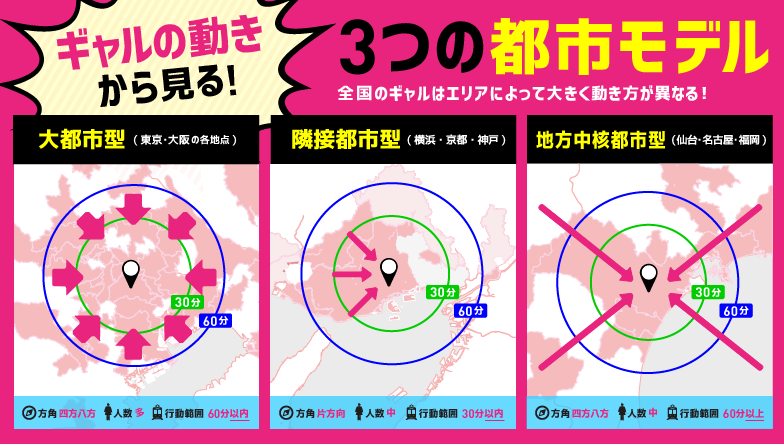
Leveraging Location Data for Marketing
By understanding people's movements like this, we can create various marketing activities from a new perspective, different from before.
For example, cross-referencing the visit patterns of the area where your store is located with the area distribution of your customer base can help evaluate past marketing activities and identify challenges.
This time, our middle-aged team successfully encountered gals through location data analysis. This means that by using location data, we observed the behavior of gals with whom we had little prior contact, gaining a glimpse into their previously unnoticed lifestyle. Similarly, I believe this approach can offer valuable insights for corporate marketing activities, such as when attempting to approach targets with whom there is currently little connection.
Moving forward, we plan to expand our focus beyond gals and share insights about other target groups as well.
*1 Mobile Spatial Statistics is statistical population information created using NTT DOCOMO's mobile phone network infrastructure. "Mobile Spatial Statistics" is a trademark of NTT DOCOMO.
※2 " Gyaru Lab@ " conducted the "5 Major Cities Women's Census" in January 2015. An online survey was conducted targeting 800 women aged 16 to 24.








